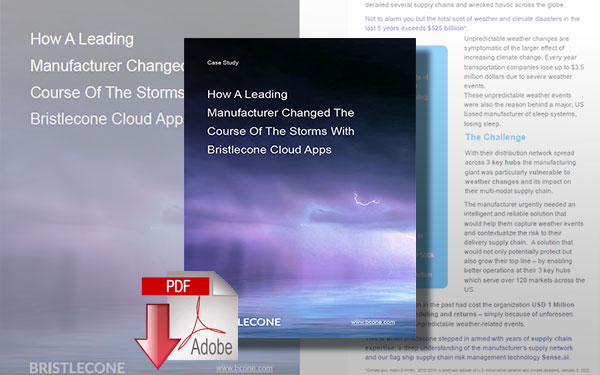Managing Supplier Risk in the Age of the Coronavirus

The coronavirus has infected countless people worldwide, surpassing the severity of the SARS outbreak but it also poses to significantly dent the global economy.
The losses incurred due to the coronavirus outnumber SARS, which cost the world economy $40 billion dollars back in 2002-2003.
Smarter organizations learnt their lessons with SARS and moved their manufacturing centers to safer places like Vietnam and India.
Yet what they missed was that even though they may have shifted assembly operations, about 70-80% of world’s components continued being sourced from China.
While the problem shifted from primary suppliers to sub suppliers – it simply resulted in lesser on ground visibility, lesser information, and lesser transparency than ever before. In times like these one starts to see the fragility of a global supply chain.
While events like these are hard to predict, how soon and the manner in which one responds to them has a close bearing on short-term losses and recovery time. For instance, what was your first reaction and response once you became aware of the worsening situation in China?
- Did you have closed door meetings to evaluate the impact on your Supply Chain?
- If so, how many came out of the meeting saying they had sufficient information to take a decision?
- Or were able to track down every single sub supplier who could potentially be impacted?
- Or knew exactly how long the inventories would last?
Disruptions of this scale do not happen often but your supply chain is constantly exposed to threats from seemingly smaller risk events that recur through the year. What they lack in scale, they make up for in frequency.
For instance, events like factory fires, strikes, power outages, capacity shutdowns, bankruptcy may be easy to ignore in isolation but add them up and you will know the damage they do to your bottom line.
With global supply chains staying global for a foreseeable future, how does one equip their Supply Chain to stay out of trouble?

1. Develop a sense, stay informed and know where to look for risk events
Information is power and timely information even more so. Many organizations depend on individual buyers and supply managers to keep a tab on their suppliers. But with thousands of suppliers this isn’t an easy or efficient mechanism.
Have a consistent and reliable way to collect and disseminate information. Reading newspapers is not enough. Leverage Technology. Sophisticated technologies have made it possible to monitor anything locally – from road disruptions, regulations to human health crisis. In this big data era, there are smart applications that can monitor specific markets and key events in and around those.
However, beware of information overload in this process so your productivity doesn’t suffer. Be prudent about what you choose to monitor, where and how.
2. Map it all
In the world of ‘just-in-time inventories’, the Ford story is one of the most relevant cases in point. During the Thailand floods they were forced to shutdown the operations of their most profitable line of cars because of their inability to get supplies in time. Later, Ford, realized that they had several sub suppliers that were also in Thailand and severely impacted as well. So the damage done was incapacitating at an overall level.
Having the entire network of sub suppliers tracked and mapped is on every sourcing organization’s wish list and rightfully so.
Gather data about sub suppliers from your primary suppliers or use third party sources to get the information to the database. For more evolved organizations this can be made a part of a stricter supplier onboarding process. Making it mandatory for primary suppliers to disclose their sub suppliers could go a long way in protecting your supply chain in future.
Also, map local supplier development teams to sub suppliers. So you know where to go and who to speak to whenever a risk threatens your Supply Chain.
3. Plan for alternates
An easier way out of such risks could be to have a ready-repository of alternative suppliers identified.
Do not wait until the last moment to discover and identify these alternate sources since your competitors and customers probably have them on their speed dial already. These alternates should be identified for every critical function of your supply chain and preferably be geographically diversified to mitigate risks.
It is crucial for your primary suppliers to zero down on alternatives since risk becomes exponentially higher as one goes down the value chain.
4. Tackle it at design stage
Sourcing is a supply organization’s drawing board. Considering the intelligence of past and future events, while making sourcing decisions builds risk resilience within an organization in the design stage itself.
IMPORTANT QUESTIONS TO ASK ARE
- Have we looked at a supplier’s proneness to such events?
- Is there transparency in revealing one’s sub supplier network?
- What does the disaster recovery look like?
- Have the suppliers identified alternatives?
Once you include these in the supplier ranking mechanism and assign relevant weights to it, you will not fall victim to the domino effect of external supply chain risk.
5. Have a continuity plan
Having a business continuity plan is considered as a hygiene factor. Ideally, everyone should know where to start and what to do when such events strike. If your organization does not have this figured, then this is the place to start and then move forward.
Related White Papers
Leading Manufacturer Uses Cloud App to Avoid Supply Chain Disruptions
Unforeseen weather events have been one of the biggest reasons for supply chain disruptions and companies are working tirelessly to find effective supply chain risk management methods to curb losses; last year, a leading manufacturer with a widespread distribution network reached out to Bristlecone to tackle this beast of unpredictable weather events. Download Now!
Related: Fighting Billion-Dollar Weather and Climate Disasters with Sense.ai 
Article Topics
Bristlecone News & Resources
Bristlecone and Aera partnership addresses “cognitive” supply chain capabilities Managing Supplier Risk in the Age of the Coronavirus How to Digitize Your Supply Chain Without Losing Your Mind How to Embrace the New Normal for Demand Planning How a Biotech Manufacturer Leveraged AI, ML, and IoT to Gain Supply Chain Visibility How Trace.ai Enhances Supply Chain Visibility Fighting Billion-Dollar Weather and Climate Disasters with Sense.ai More BristleconeLatest in Supply Chain
Trucking Industry Pushes Back on Government’s Electric Mandates Senators Take Aim at Amazon with Warehouse Worker Protection Act Maersk Sees Silver Lining in Red Sea Shipping Challenges Happy Returns Partners With Shein and Forever 21 to Simplify Returns Baltimore Opens 45-Foot Deep Channel Following Bridge Collapse El Paso Border Delays Cost Juarez $32 Million Per Day in Economic Losses Ranking the World’s 10 Biggest Supply Chains More Supply Chain














